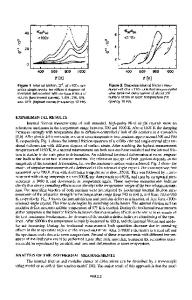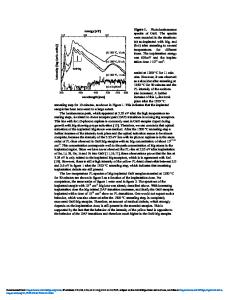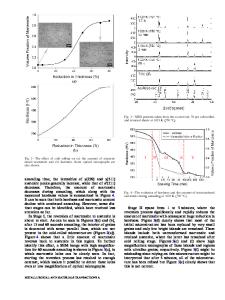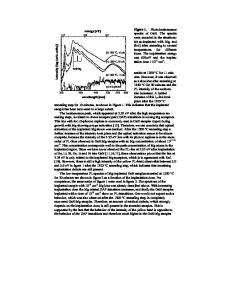Photoluminescence Study of Plastically Deformed GaN
- PDF / 420,550 Bytes
- 6 Pages / 612 x 792 pts (letter) Page_size
- 21 Downloads / 320 Views
E5.11.1
Photoluminescence Study of Plastically Deformed GaN I. Yonenaga, H. Makino, S. Itoh, T. Goto,1 and T. Yao1 Institute for Materials Research, Tohoku University, Katahira, Sendai 980-8577, Japan 1 Center for Interdisciplinary Research, Tohoku University, Aramaki, Sendai 980-8578, Japan ABSTRACT We report the photoluminescence characteristics of fresh dislocations introduced by the plastic deformation in GaN bulk crystals. GaN crystals prepared from free standing wafers grown by the HVPE technique were compressed plastically at 900 to 1000˚C. In the deformed crystals (a/3) [112 0] dislocations on the (1 1 00) prismatic plane, corresponding to the so-called threading dislocations, were observed in TEM. In the PL studies at 11K the intensity of the near band-edge luminescence decreased drastically in the deformed GaN by about 1/12 than that of the as-grown GaN, which seems to imply the introduction of a high density of non-radiative ! ! during the plastic deformation. By the plastic deformation the recombination centers into GaN yellow band luminescence decreased remarkably meanwhile the red band and other new luminescence developed relatively. It is found that dislocations do not originate to the yellow luminescence but the red luminescence. INTRODUCTION GaN and related nitride alloys are attracted keen interest as wide-band-gap semiconductor for applications in e.g. high-power or high-frequency devices, blue- and ultraviolet light-emittingdevices and lasers, and chemically stable substrates. GaN alloys are grown on a wide variety of foreign substrates with large lattice mismatches and significant differences in the thermal expansion coefficients. This hetero-epitaxial growth leads to the introduction of various types of grown-in extended defects such as dislocations, prismatic stacking faults, nanopipes, and so on. The most interesting experimental finding is that GaN exhibits high optical efficiency even when it contains a high density of so-called threading dislocations of the order of 107-109 cm-2 mostly parallel to the growth direction c-axis [0001], unlike other III-V semiconductors such as GaAs and GaP [1]. From this viewpoint, many experimental (e.g. [1–5]) and theoretical works (e.g. [6-10]) on the optical and electronic properties of dislocations have been carried out, although even now the effects of dislocations are still not clear. Typically it remains a matter of controversy whether a broad luminescence, known as the yellow band (YB), is being originated from a recombination at a dislocation-impurity complex. The properties of dislocations in as-grown crystals should be affected by the decoration of native point defects or impurities during the growth process. Thus, investigation of the intrinsic properties of “fresh” dislocations becomes necessary. Cathodoluminescence studies of dislocations on the basal plane induced by the indentation method have been recently reported by Albrecht et al. [11] and Lee et al. [12]. Then, screw-type dislocations on the basal plane are shown to act as non-radiative
Data Loading...










